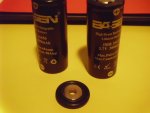If I might take a moment to grab the wheel and steer this conversation in a more productive direction...
Never seemed to me to be a good idea to apply soldering temperatures, however briefly, to something as temperamental as a Li-Ion battery. Yes, I have tried the rare-earth magnets, and they do seem to work well, for the lower-current (say, 1 to 2.5A) green and red diodes (it's worth pointing out that the current is actually carried by the nickel plating, NOT the magnetic core, so the resistance of the NdBFe core is irrelevant). But, that said, for the high current "Big Blues" (3 to 6 A), the small cross-sectional area of the plating becomes problematic, and a lower-resistance solution is preferred







